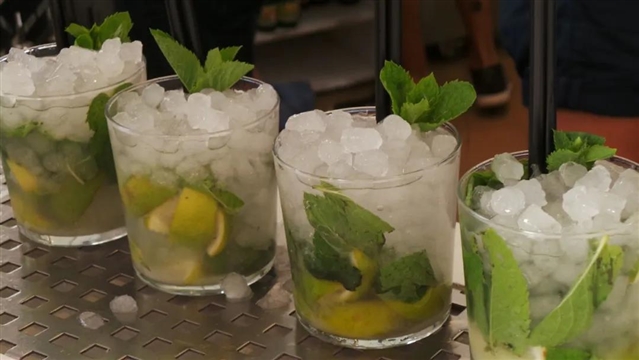|
|
| 如果有足够的无酒精选项,你还会贪杯Mojito么? | BMC Public Health |
|
论文标题:The impact on selection of non-alcoholic vs alcoholic drink availability: an online experiment
期刊:BMC Public Health
作者:Anna K. M. Blackwell, Katie De-loyde et.al
发表时间:2020/05/06
数字识别码:10.1186/s12889-020-08633-5
微信链接:点击此处阅读微信文章
原文作者:Anna Blackwell
让健康食品变得更易获得能提升人们对它们的选择和购买。同样的道理在酒精饮品中是否也适用呢?近期,Anna Blackwell博士在BMC Public Health上发表了一篇文章,该文章探讨了如果让非酒精饮品比起酒精饮品更易获得,是否能够提升人们对它们的选择。

图1
不管我们是在酒吧聚会、聚餐,或是邀请朋友到家里来,我们第一件要考虑的事通常是:“我要喝点什么?”酒吧、餐厅和超市通常都能提供大量的选择,它们有超长的菜单,清晰的描述每种饮品的味道,还有各种特价。而所有这些的共同点是:到处都有酒。
在英国大部分成年人都会喝酒,其中大概一半每周都会喝酒。对于大部分人来说喝酒的风险还比较低,但是有三分之一的男人和七分之一的女人饮酒量超出了现行的英国低风险饮酒指南给出的建议(每周14单位)。这种行为提升了患上酒精相关疾病的风险,这些疾病包括口腔癌、食道癌、乳腺癌、中风和心脏病。
提升酒的价格是一种有效减少酒精消费的方式。不过我们对其他可能的方式也很感兴趣。具体来说,我们主要感兴趣的是改变饮酒环境是否能改变饮酒行为。之前的研究显示,如果将一部分不那么健康的食物和零食替换为健康食物的话,人们就更可能购买并食用健康食物。我们的研究调查了改变非酒精饮品相对于酒精饮品的获取难度是否能对于人们的选择有相似的影响。
我们让808位每周都会喝啤酒的成年人参与我们的线上调查。我们要求他们从展示的一系列非酒精饮品(软饮料和无酒精啤酒)和酒精饮品(啤酒)中选择他们今天想喝的一种。一共有四组可能的饮品组合可供选择,要么是有相同数量的酒精饮品和非酒精饮品(各2个或各4个),要么是非酒精饮品的比例更高或更低(6个非酒精饮品和2个酒精饮品,或者2个非酒精饮品和6个酒精饮品)。
在真实环境中,比如在超市或繁忙的酒吧,人们通常需要快速选择他们要喝什么。所以我们让一半的被试者在较短的时间限制内选择。
我们发现,当备选饮品总数和非酒精饮品的比例都提高时,被试者选择非酒精饮品的概率提升了71%;当只有非酒精饮品的比例提高时,被试者选择非酒精饮品的概率提升了48%。当两种饮品的比例不变时,没有证据表明提升非酒精饮品的数量能够提升被试者对其的选择。没有证据表明限制时间会影响他们对饮品的选择。
就我们所知,这是第一次有证据表明,采取措施提升非酒精饮品获取的容易程度——特别是它们相对于酒精饮品的比例——能够帮助减少人们对酒精的选择。
虽然很多酒吧和饭店都至少提供一种无酒精啤酒,但这通常都是藏在吧台后面的冰箱里,或者菜单的背面,而且非酒精饮品的数量通常都有限。这些酒精替代品缺乏可见性,因此顾客需要付出更多的努力才能选择它们。然而这些饮品的市场正在增长,这就能为顾客提供更多的选择。随着时间推移,增加非酒精饮品的曝光度能够帮助改变关于这些饮品的社会习惯。
采取措施来提升非酒精饮品的比例非常适时,并且不仅对于政策制定者有意义,同时还对许可证持有者和饮品生产商也非常有意义。现在需要在现实世界中的研究来帮助我们理解酒精摄入的潜在影响。
BMC Public Healthis an open access, peer-reviewed journal that considers articles on the epidemiology of disease and the understanding of all aspects of public health. The journal has a special focus on the social determinants of health, the environmental, behavioral, and occupational correlates of health and disease, and the impact of health policies, practices and interventions on the community.
Citation Impact
2.567 - 2-year IF
3.275 - 5-year IF
1.342 - SNIP
1.382 - SJR
摘要:
Background
Increasing the availability of healthier food increases its selection and consumption. However, there is an absence of evidence related to alcohol. This study aimed to estimate the impact of increasing the absolute and relative availability of non-alcoholic compared to alcoholic drinks on selection. We also assessed whether effects were modified by cognitive resource.
Methods
UK adult weekly alcohol consumers (n = 808) were recruited to an online experiment with a hypothetical drink selection task. Participants were randomly assigned to one of eight conditions, in a 4 (availability) × 2 (cognitive resource) factorial design. The four availability conditions were: i. Reference 1 (two non-alcoholic, two alcoholic drinks); ii. Reference 2 (four non-alcoholic, four alcoholic drinks); iii. Increased non-alcoholic drinks (six non-alcoholic, two alcoholic drinks); iv. Increased alcoholic drinks (two non-alcoholic, six alcoholic drinks). The two cognitive resource conditions were: a. Low (high time pressure); b. High (low time pressure). Logistic regression was used to assess selection of a non-alcoholic drink.
Results
49% of participants selected a non-alcoholic drink in the Increased non-alcoholic drinks condition, compared to 36% in Reference 1, 39% inReference 2, and 26% in the Increased alcoholic drinks condition. Non-alcoholic drink selection was similar between Reference 1 and 2 when the total number of drinks increased (absolute availability) but the proportion of non-alcoholic compared to alcoholic drinks (relative availability) was unchanged (OR = 1.15, 95% CI 0.77, 1.73). In contrast, the odds of selecting a non-alcoholic drink were 71% higher when both absolute and relative availability of non-alcoholic compared to alcoholic drinks was increased from Reference 1 to the Increased non-alcoholic drinks condition (OR: 1.71, 95% CI 1.15, 2.54), and 48% higher when increased from Reference 2 to the Increased non-alcoholic drinkscondition (OR: 1.48, 95% CI 0.99, 2.19). There was no evidence of an effect of cognitive resource.
Conclusions
Greater availability of non-alcoholic drinks, compared to alcoholic drinks, increased their online selection, an effect that may be larger when changing their relative availability, i.e., increasing the proportion of non-alcoholic drinks. Naturalistic studies are needed to determine the impact of availability interventions on reducing alcohol purchasing and consumption.
(来源:科学网)
特别声明:本文转载仅仅是出于传播信息的需要,并不意味着代表本网站观点或证实其内容的真实性;如其他媒体、网站或个人从本网站转载使用,须保留本网站注明的“来源”,并自负版权等法律责任;作者如果不希望被转载或者联系转载稿费等事宜,请与我们接洽。